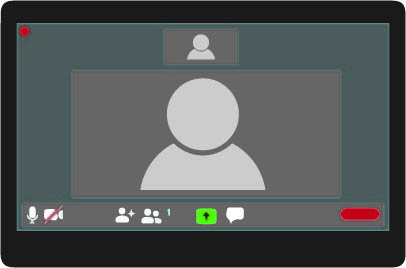Fall 2020 Academic Structure: One Student’s Perspective
Was there structure? Will it get better by Spring 2021?

Elizabeth Kaiser graphic
COVID this, COVID that. This year’s pandemic has truly brought out what we should be thankful for, and ultimately it has shown what we can improve on. Whether it is the aspects of education or other areas, our sense of unity needed at desperate times calls for action to be taken.
By far, this semester has been one of the worst, if not the actual worst, of my lifetime and many people can relate. The amount of stress given to me on top of my mental health issues has been insurmountable, and although I should be using them to feed a sense of gratitude when I overcome the barriers, they keep getting taller and longer. It is to the point where I cannot overcome them. The one wall is anxiety, and I may be able to punch holes in that wall, but the second wall behind it is depression and the third ADHD.
I am an involved student with the Services for Students with Disabilities Office (SSWD), and I have not renewed my VISA yet. Registering next semester for classes really, REALLY put me in a dilemma. Do I continue my education virtually? Are my symptoms going to be the same next semester? How can I better myself academically? I have already tried using Academic Success Coaching, but this year does not seem the same as previous years. I consistently and constantly (at least I think) send my professors emails about my situation, but how long will it be until they are going to be fed up?
I understand, things come up in our everyday lives. This fall has brought many days when I had to quarantine from my in-person classes after being contacted by a contact tracer. I was only in my completely in-person class for 12 class periods. That is when I decided to drop my class because I was so far behind trying to maintain my health awareness and security. Those many weeks quarantining while maintaining the Three Ws and getting tested caused not only my mental health to decline, but I believe that there was even a correlation to my physical health declining.
In the middle of October, I noticed my migraines started coming back. They have sent me to the emergency room once, and I have had many, many doctor appointments regarding this issue. After election season, one migraine was so painful it triggered my body to go unconscious and fall. Following the fall, I had the symptoms of a severe concussion, which led to doctor’s orders restricting me from normal activities for quite some time. With these migraines, it branched off to setting an appointment with Neurology, Pulmonology, Ophthalmology and general follow-ups with my Primary Care Provider. Could this all be stress-related?
I am someone who was raised with the ideology “There are no excuses. Just be better.” This time, I am literally trying to drag a massive weight, called my college career, across the satisfactory finish line by one thin string that could snap at any second. I am just trying to make the best of my education. At this point in time, however, the limited number of in-person classes and the lack of course structure have caused me to rethink my plans for the spring.
What can we, as students, do to inform our professors when we experience a problem? As Student Senate members explained during a general staff meeting, “The way to address a problem with your course is to contact the professor, then if it is not resolved, you go to the department chair, then the dean of your college, then upper leadership. The Dean of Students could also assist you if you feel intimidated.”
This is not enough to help the student population. There needs to be as much consistency as possible, since we have now had seven months to learn Canvas, Zoom and other modes of virtual assistance when it comes to shifting pedagogy.
During my first semester at the University of Wisconsin-Platteville, professors were introduced to Canvas. Desire 2 Learn (D2L) became a thing of the past. Some professors even started emailing their students about “CanvASS.” I understand; change is something humans have experienced from the beginning of our existence. We learn to adapt to certain environments. Now it is our time to move on from complaints about Canvas to utilizing it more for student success.
Canvas has its problems, but we also need to consider other possibilities as to why students and faculty still struggle with the online structure. If we are going to rely on virtual delivery of courses, we need Canvas to be the sole medium to make our Pioneer students more successful and organized during this unfortunate time of COVID-19. Some students have struggles maintaining the organization of all forms of delivery.
Let’s feel like our Student Technology and Engagement Fund is at its fullest use. Money is a problem, but when students leave or are not registering for classes, it leads to uncertainty about the campus’ future budget. I want to restore my faith in this university since it feels like somewhere I can succeed, but most importantly, I want to restore the Pioneer community’s faith in their ability to succeed here.



